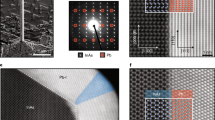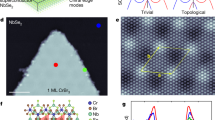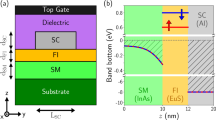Abstract
Controlling the properties of semiconductor/metal interfaces is a powerful method for designing functionality and improving the performance of electrical devices. Recently semiconductor/superconductor hybrids have appeared as an important example where the atomic scale uniformity of the interface plays a key role in determining the quality of the induced superconducting gap. Here we present epitaxial growth of semiconductor–metal core–shell nanowires by molecular beam epitaxy, a method that provides a conceptually new route to controlled electrical contacting of nanostructures and the design of devices for specialized applications such as topological and gate-controlled superconducting electronics. Our materials of choice, InAs/Al grown with epitaxially matched single-plane interfaces, and alternative semiconductor/metal combinations allowing epitaxial interface matching in nanowires are discussed. We formulate the grain growth kinetics of the metal phase in general terms of continuum parameters and bicrystal symmetries. The method realizes the ultimate limit of uniform interfaces and seems to solve the soft-gap problem in superconducting hybrid structures.
This is a preview of subscription content, access via your institution
Access options
Subscribe to this journal
Receive 12 print issues and online access
$259.00 per year
only $21.58 per issue
Buy this article
- Purchase on Springer Link
- Instant access to full article PDF
Prices may be subject to local taxes which are calculated during checkout






Similar content being viewed by others
References
Lutchyn, R. M., Sau, J. D. & Das Sarma, S. Majorana fermions and a topological phase transition in semiconductor–superconductor heterostructures. Phys. Rev. Lett. 105, 077001 (2010).
Oreg, Y., Refael, G. & von Oppen, F. Helical liquids and Majorana bound states in quantum wires. Phys. Rev. Lett. 105, 177002 (2010).
Mourik, V. et al. Signatures of Majorana fermions in hybrid superconductor–semiconductor nanowire devices. Science 336, 1003–1007 (2012).
Das, A. et al. Zero-bias peaks and splitting in an Al–InAs nanowire topological superconductor as a signature of Majorana fermions. Nature Phys. 8, 887–895 (2012).
Deng, M. T. et al. Anomalous zero-bias conductance peak in a Nb–InSb nanowire–Nb hybrid device. Nano Lett. 12, 6414–6419 (2012).
Churchill, H. O. H. et al. Superconductor-nanowire devices from tunneling to the multichannel regime: Zero-bias oscillations and magnetoconductance crossover. Phys. Rev. B 87, 241401 (2013).
Stanescu, T. D. & Das Sarma, S. Superconducting proximity effect in semiconductor nanowires. Phys. Rev. B 87, 180504 (2013).
Takei, S., Fregoso, B. M., Hui, H-Y., Lobos, A. M. & Das Sarma, S. Soft superconducting gap in semiconductor Majorana nanowires. Phys. Rev. Lett. 110, 186803 (2013).
Kroemer, H. Quasielectric fields and band offsets: Teaching electrons new tricks. Rev. Mod. Phys. 73, 783–793 (2001).
Lauhon, L. J., Gudiksen, M. S., Wang, D. & Lieber, C. M. Epitaxial core-shell and core-multishell nanowire heterostructures. Nature 420, 57–61 (2002).
Björk, M. T. et al. One-dimensional steeplechase for electrons realized. Nano Lett. 2, 87–89 (2002).
Heiss, M. et al. Self-assembled quantum dots in a nanowire system for quantum photonics. Nature Mater. 12, 439–444 (2013).
Wallentin, J. et al. InP nanowire array solar cells achieving 13.8% efficiency by exceeding the ray optics limit. Science 339, 1057–1060 (2013).
Borg, M. et al. Vertical III–V nanowire device integration on Si(100). Nano Lett. 14, 1914–1920 (2014).
Li, M. et al. Bottom-up assembly of large-area nanowire resonator arrays. Nature Nanotech. 3, 88–92 (2008).
Pilkington, S. J. & Missous, M. The growth of epitaxial aluminum on As containing compound semiconductors. J. Cryst. Growth 196, 1–12 (1999).
Dick, A. K. et al. Synthesis of branched ‘nanotrees’ by controlled seeding of multiple branching events. Nature Mater. 3, 380–384 (2004).
Zheleva, T., Jagannadham, K. & Narayan, J. Epitaxial growth in large-lattice mismatch systems. J. Appl. Phys. 75, 860–871 (1994).
Krogstrup, P. et al. Advances in the theory of nanowire growth dynamics. J. Phys. D: Appl. Phys. 46, 313001 (2013).
Little, W. A. & Parks, R. D. Observation of quantum periodicity in the transition temperature of a superconducting cylinder. Phys. Rev. Lett. 9, 9–12 (1962).
Liu, Y. et al. Destruction of the global phase coherence in ultrathin, doubly connected superconducting cylinders. Science 294, 2332–2334 (2001).
Staley, N. E. & Liu, Y. Manipulating superconducting fluctuations by the Little–Parks–de Gennes effect in ultrasmall Al loops. Proc. Natl Acad. Sci. USA 11, 14819–14823 (2012).
Meservey, R. & Tedrow, P. Properties of very thin aluminum films. J. Appl. Phys. 42, 51–55 (1971).
Chang, W. et al. Hard gap in epitaxial semiconductor–superconductor nanowires. Nature Nanotech. http://dx.doi.org/10.1038/nnano.2014.306 (2015).
Rainis, D. & Loss, D. Majorana qubit decoherence by quasiparticle poisoning. Phys. Rev. B 85, 174533 (2012).
Joyez, P., Lafarge, P., Filipe, A., Esteve, D. & Devoret, M. H. Observation of parity-induced suppression of Josephson tunneling in the superconducting single electron transistor. Phys. Rev. Lett. 72, 2458–2461 (1994).
De Gennes, P. G. Boundary effects in superconductors. Rev. Mod. Phys. 36, 225–237 (1964).
Doh, Y. J. et al. Tunable supercurrent through semiconductor nanowires. Science 309, 272–275 (2005).
Van Dam, J. A., Nazarov, Y. V., Bakkers, E. P. A. M., De Franceschi, S. & Kouwenhoven, L. P. Supercurrent reversal in quantum dots. Nature 442, 667–670 (2006).
Momma, K. & Izumi, F. VESTA 3 for three-dimensional visualization of crystal, volumetric and morphology data. J. Appl. Crystallogr. 44, 1272 (2011).
Acknowledgements
We wish to thank B. Wenzell, L. Schulte and J. B. Wagner for TEM sample preparation, W. Zhang for assistance on TEM and EDX analyses, G. Ungaretti for substrate preparation and C. B. Sørensen for technical assistance. We acknowledge financial support by Microsoft Project Q, EU FP7 project SE2ND (no. 271554), the Danish Strategic Research Council, the Danish Advanced Technology Foundation, the Carlsberg Foundation and the Lundbeck Foundation. The Center for Quantum Devices is supported by the Danish National Research Foundation.
Author information
Authors and Affiliations
Contributions
P.K., T.S.J., M.H.M. and J.N. developed materials growth and analysis. N.L.B.Z., W.C., S.M.A., C.M.M. and T.S.J. performed transport measurements. E.J. and N.L.B.Z. performed TEM imaging.
Corresponding authors
Ethics declarations
Competing interests
The authors declare no competing financial interests.
Supplementary information
Supplementary Information
Supplementary Information (PDF 1843 kb)
Rights and permissions
About this article
Cite this article
Krogstrup, P., Ziino, N., Chang, W. et al. Epitaxy of semiconductor–superconductor nanowires. Nature Mater 14, 400–406 (2015). https://doi.org/10.1038/nmat4176
Received:
Accepted:
Published:
Issue Date:
DOI: https://doi.org/10.1038/nmat4176
This article is cited by
-
Parity-conserving Cooper-pair transport and ideal superconducting diode in planar germanium
Nature Communications (2024)
-
Controlled formation of three-dimensional cavities during lateral epitaxial growth
Nature Communications (2024)
-
Quantifying quantum coherence of multiple-charge states in tunable Josephson junctions
npj Quantum Information (2024)
-
Spin-polarized Majorana zero modes in proximitized superconducting penta-silicene nanoribbons
Scientific Reports (2023)
-
Phase-dependent Andreev molecules and superconducting gap closing in coherently-coupled Josephson junctions
Nature Communications (2023)



